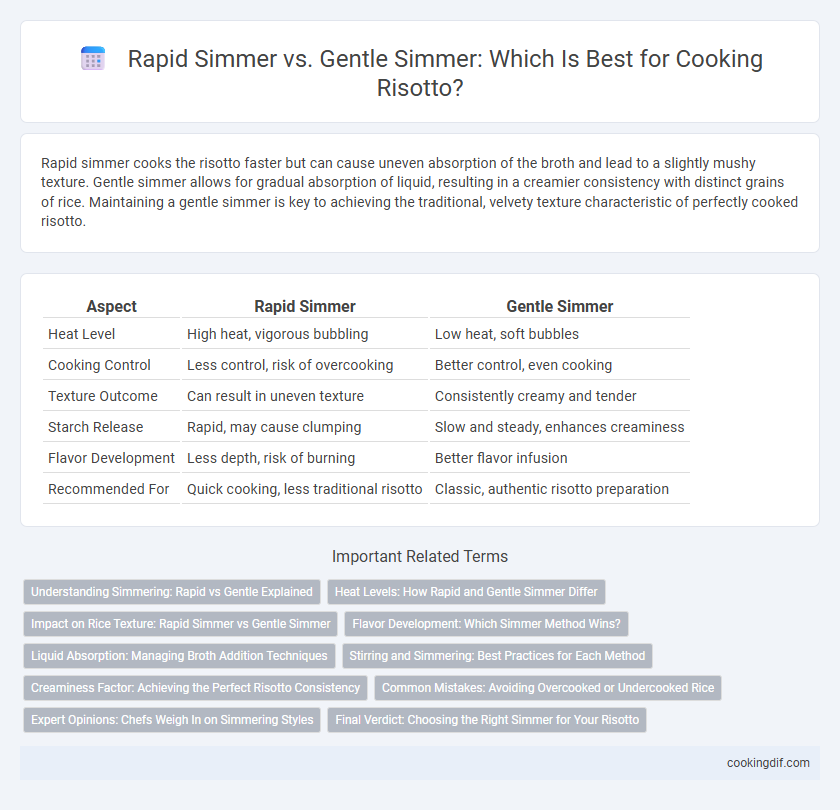Rapid simmer cooks the risotto faster but can cause uneven absorption of the broth and lead to a slightly mushy texture. Gentle simmer allows for gradual absorption of liquid, resulting in a creamier consistency with distinct grains of rice. Maintaining a gentle simmer is key to achieving the traditional, velvety texture characteristic of perfectly cooked risotto.
Table of Comparison
| Aspect | Rapid Simmer | Gentle Simmer |
|---|---|---|
| Heat Level | High heat, vigorous bubbling | Low heat, soft bubbles |
| Cooking Control | Less control, risk of overcooking | Better control, even cooking |
| Texture Outcome | Can result in uneven texture | Consistently creamy and tender |
| Starch Release | Rapid, may cause clumping | Slow and steady, enhances creaminess |
| Flavor Development | Less depth, risk of burning | Better flavor infusion |
| Recommended For | Quick cooking, less traditional risotto | Classic, authentic risotto preparation |
Understanding Simmering: Rapid vs Gentle Explained
Rapid simmer involves vigorous bubble activity around 205degF (96degC), causing constant movement that can disrupt the delicate starch release in risotto. Gentle simmer maintains a steady 185-200degF (85-93degC) with small bubbles, promoting even cooking and optimal starch gelatinization for creamy texture. Controlling the simmer intensity ensures perfect absorption of broth and prevents rice from becoming mushy or undercooked.
Heat Levels: How Rapid and Gentle Simmer Differ
Rapid simmer involves maintaining a higher heat level with bubbles breaking the surface continuously, promoting faster cooking but requiring close attention to prevent burning. Gentle simmer uses lower heat with small, occasional bubbles, allowing for even cooking and better flavor absorption in the risotto grains. Adjusting heat between rapid and gentle simmer influences starch release and texture, crucial for achieving the creamy consistency characteristic of perfect risotto.
Impact on Rice Texture: Rapid Simmer vs Gentle Simmer
A rapid simmer causes the rice grains in risotto to cook unevenly, often resulting in a mushy exterior and undercooked core due to the aggressive bubbling and fluctuating temperature. Gentle simmering maintains a steady, moderate heat that allows the rice to absorb liquid slowly and evenly, producing a creamy texture with tender, al dente grains characteristic of perfect risotto. Controlling the simmer intensity directly influences the starch release and moisture absorption, crucial for achieving the desired consistency and mouthfeel.
Flavor Development: Which Simmer Method Wins?
Gentle simmer enhances risotto's flavor development by allowing rice grains to absorb broth slowly, releasing starch gradually and creating a creamy texture with deeper, more integrated flavors. Rapid simmer can cause uneven cooking, risking a burnt bottom and less nuanced taste as the rice starches do not have sufficient time to develop fully. Consistent, gentle simmering ensures balanced heat distribution, promoting optimal flavor extraction from ingredients like onions, garlic, and broth.
Liquid Absorption: Managing Broth Addition Techniques
Rapid simmer can cause uneven liquid absorption in risotto, leading to inconsistent texture and longer cooking time. Gentle simmer allows gradual broth integration, promoting even starch release and smooth, creamy consistency. Managing broth addition with gentle simmer ensures optimal absorption, preventing grain overcooking or undercooking.
Stirring and Simmering: Best Practices for Each Method
Rapid simmering requires frequent stirring to prevent rice from sticking and ensures even heat distribution, promoting a creamy texture in risotto. Gentle simmering allows for slower absorption of broth, reducing the need for constant stirring and preserving the integrity of the rice grains. Optimal risotto cooking balances stirring intensity with simmering speed to achieve a smooth, perfectly cooked dish.
Creaminess Factor: Achieving the Perfect Risotto Consistency
Gentle simmer is essential for achieving the perfect risotto creaminess, as it allows the rice to release starch gradually, creating a smooth and velvety texture. Rapid simmer accelerates liquid absorption but risks uneven cooking and a less creamy consistency due to the starch not fully breaking down. Maintaining a gentle simmer ensures controlled heat, optimal starch release, and the signature creamy consistency that defines authentic risotto.
Common Mistakes: Avoiding Overcooked or Undercooked Rice
Maintaining a gentle simmer during the risotto cooking process ensures even heat distribution, preventing both overcooked, mushy grains and undercooked, hard centers. Rapid simmer can cause uneven cooking, leading to a compromised texture and loss of the perfect creamy consistency that characterizes traditional risotto. Consistent low heat allows gradual absorption of broth, critical for achieving the ideal al dente bite.
Expert Opinions: Chefs Weigh In on Simmering Styles
Expert chefs emphasize that gentle simmering maintains consistent heat, ensuring the rice grains cook evenly while gradually absorbing broth for creamy texture in risotto. Rapid simmering can cause uneven cooking and risk breaking the grain structure, leading to a less refined mouthfeel. Maintaining a gentle simmer aligns with traditional Italian risotto recipes, enhancing starch release and achieving the signature velvety consistency.
Final Verdict: Choosing the Right Simmer for Your Risotto
Gentle simmer is ideal for risotto as it allows gradual starch release from the rice, resulting in a creamy, evenly cooked texture. Rapid simmer can cause uneven cooking and risk of burning the bottom, compromising flavor and consistency. For optimal risotto, maintain a gentle simmer to ensure perfect absorption of broth and creamy, luscious results.
Rapid simmer vs Gentle simmer for cooking process Infographic

 cookingdif.com
cookingdif.com